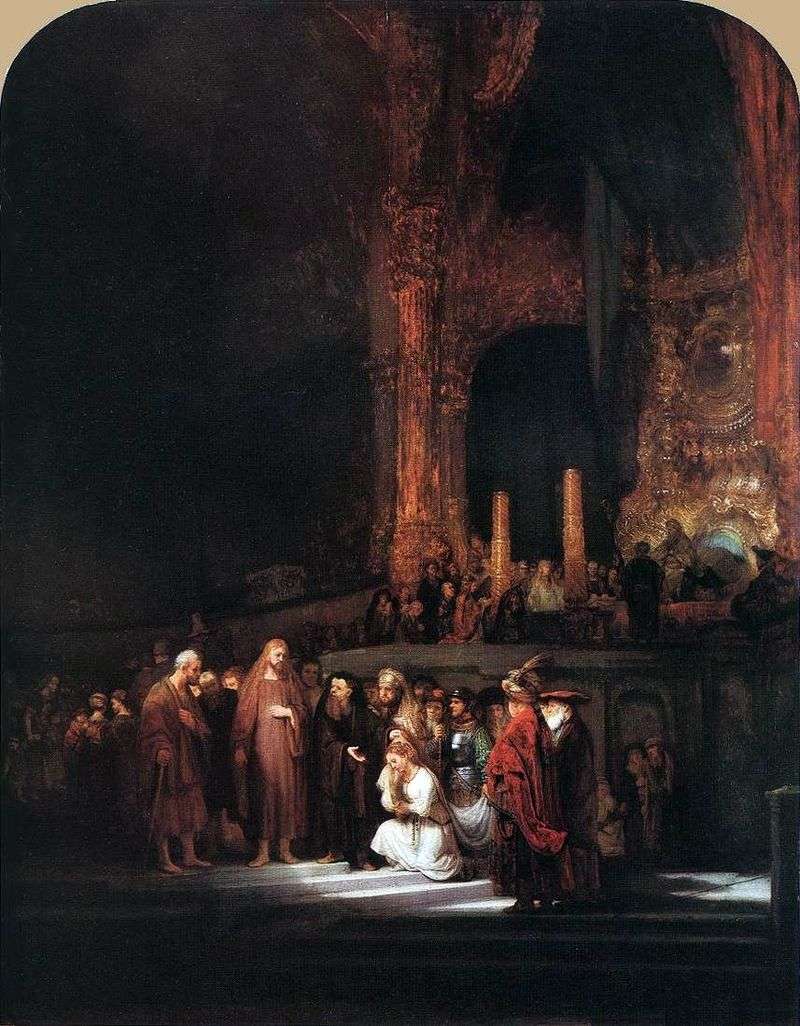
The famous canvas of Alexander Ivanov “The Appearance of Christ to the People” made a huge impression on all who had seen it with their own eyes. Everyone who was involved in painting, closely followed the creation of a painting for a long 20 years and dreamed in the future to write an equally masterpiece work filled with deep ethical content. Among them was the young artist Vasily Polenov. He embodied his aspirations to create a spiritual dramatic canvas in the monumental work “Christ and the Sinner.”
The biblical legend about the meeting of Christ with the sinner was taken as the basis of the plot chosen for writing the picture. According to the legend, a woman accused of sinful adultery – was brought to Jesus in the temple. The men who accompanied her turned to him with the question of how to deal with the ungodly – after all, Moses had taught him to stone everyone who had committed this sin. To which Christ replied: “If among you there is a sinless one, then let him throw a stone at her.” And he continued to write, without uttering another word. Gradually, people began to disperse, and not a single stone was thrown at the woman. When there was no one left in the temple except them, Jesus told her that, just like everyone else, he would not judge her and let her go home, ordering her not to sin again.
Painting the picture was preceded by a thorough preparatory work. So, the conceived canvas should have been rather large in size – 3.07 m by 5.85 m. In Russia, these canvases were not produced, so the artist had to go to Italy and order a canvas there. This trip was not the last – Polenov visited Egypt, Palestine and Syria more than once, in order to study more closely the customs, life and colors of the Jews of the time of Christ. While traveling to the East, the artist wanted to feel the atmosphere of biblical traditions on himself, and then transferred the historically authentic situation on the canvas. In total, while working on the painting, Polenov made more than 150 preliminary drawings, sketches and sketches, some of which are currently stored in the State Russian Museum.
For the first time the artist presented his work in February 1887 at the XV exhibition of the Association of the Wanderers. According to the original plan, the name of the picture was different – “Who among you is without sin?”. Polenov believed that it was this phrase that personified the idea of forgiving neighbor love and moral self-improvement. But the censors allowed to put the picture subject to the replacement of the name to “Christ and the sinner.” The work as a whole was also condemned by the censors and defined as harmful to the people. But, oddly enough, the canvas impressed Emperor Alexander III, who not only allowed her to the demonstration, but also bought a painting for his museum.
What caused the picture of such heated debates and ambiguous opinions? The fact is that Polenov in his work broke the canonical traditions of the artistic image of Jesus. He did not write God, but a wise philosopher-wanderer, concentrating mainly on his human qualities. Jesus is as close as possible to the common man – depicted sitting in a calm, slightly tired pose, dressed in clothes that do not stand out from other people’s attire. The background on which the picture unfolds is also deprived of mysticism and reflects the daily life of the eastern city. The artist sought such an understanding of the picture, according to which Christ would be perceived not as God, but as a person with a huge soul. And he managed to do it.
 Who do people honor me by Vasily Polenov
Who do people honor me by Vasily Polenov Lake Genisaret by Vasily Polenov
Lake Genisaret by Vasily Polenov Constantinople. Golden Horn by Vasily Polenov
Constantinople. Golden Horn by Vasily Polenov Christ and the Sinner by Rembrandt Harmens Van Rhine
Christ and the Sinner by Rembrandt Harmens Van Rhine Monastery over the river by Vasily Polenov
Monastery over the river by Vasily Polenov Resurrection of Jairus’ daughter by Vasily Polenov
Resurrection of Jairus’ daughter by Vasily Polenov Right mister by Vasily Polenov
Right mister by Vasily Polenov Among the teachers by Vasily Polenov
Among the teachers by Vasily Polenov